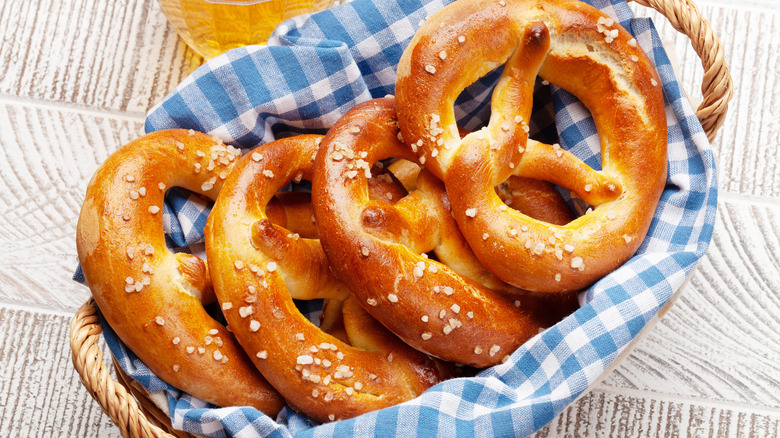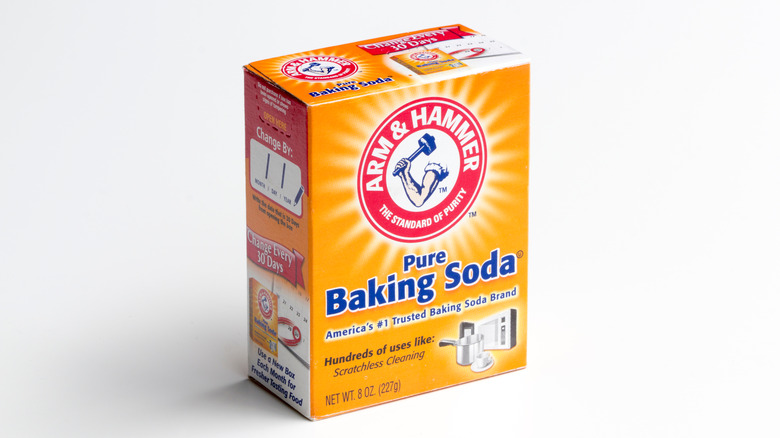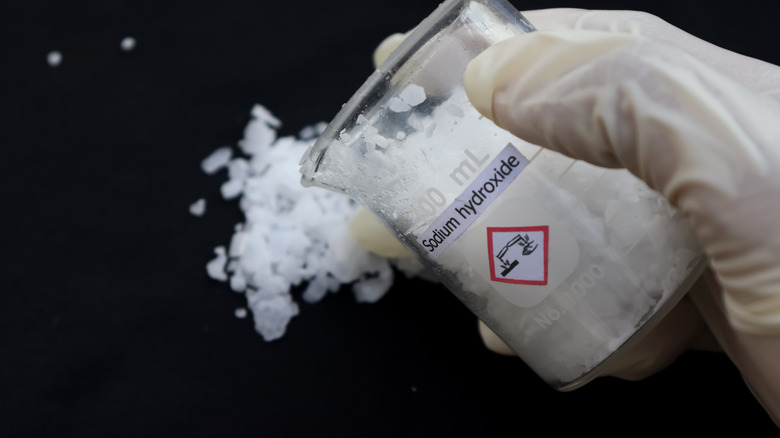The Safe, Secret Ingredient To Elevate Homemade Bavarian Soft Pretzels
A soft pretzel, at its most basic, is strikingly similar to bread dough that's been tied into a distinct shape, baked until golden brown, and topped with salt. But somehow, perhaps through some culinary miracle, the whole thing just works. It is one of life's many little joys to dig into a warm soft pretzel, with its salty crunchy exterior and pillowy soft interior that's perfect for dipping into mustard or beer cheese. Whether you microwave them or bake them, nothing beats a good soft pretzel.
Perhaps the type of soft pretzel most people are familiar with is the Bavarian soft pretzel. The reason we associate pretzels with German culture is thanks to the pretzel's connections with the early Catholic Church in medieval Europe. According to The Grenchus Foundation, Germans fasting during the Lent season created the pretzel as a way to eat without breaking their fast, with the unique symbol of the pretzel being said to represent the Holy Trinity. Some sources, such as GermanFoods, tell us that pretzels were invented by a monk to reward children for their daily prayer lessons, with the "arms" of the pretzel resembling a child's hands crossed in prayer. Whatever the reason, the Bavarian soft pretzel, with its crunchy exterior and soft interior, is viewed as one of the quintessential types of soft pretzels to try.
If you're making Bavarian soft pretzels at home, there's one ingredient that you probably shouldn't skip over to get the best pretzel you can.
An alkaline solution helps gives the pretzels their flavor
If pretzels and bread have very similar ingredients, have you ever wondered what gives pretzels their distinct flavor? According to Food and Wine, the unique pretzel flavor comes from the pretzel being washed in an alkaline solution such as baking soda before being baked. But how does alkaline solution give you that unique flavor?
Chef Billy Parsi details that, when you "parboil," or boil your pretzels in a solution before baking, you're allowing the mixture of baking soda and water to "gelatinize" the dough. The baking soda, which is known for its neutralizing and cleaning abilities thanks to it being sodium bicarbonate (via Farmer's Almanac), reacts with the dough, giving it a soft and airy interior and a crisp, golden crust on the exterior.
Food and Wine elaborates that, should you find yourself wanting a much richer flavor that is more traditional of Bavarian pretzels, you should first bake your baking soda before adding it to your mixture. Heating your baking soda lowers its pH level and makes it more acidic, thus heightening its properties. The New York Times offers similar advice, explaining that "baked" baking soda is also a key ingredient in dishes such as Chinese alkaline noodles.
But you may remember that we said this is a "safe" ingredient. What exactly did we mean by that, and what is the "riskier" alternative to baking soda?
You could also use food-grade lye.
You may have seen lye used in soaps or to dissolve other chemicals. In fact, you may have even heard of certain reports of people being burned by the substance, such as one woman in 2013 (via CBS News). SA Health tells us that lye can be extremely dangerous if consumed or splashed on the skin, giving extremely painful and severe burns. Why, then, would such a substance be used in cooking and in pretzels of all things?
According to King Arthur Baking, lye and caustic sodas are used in the process of baking pretzels because lye's reaction to the pretzels, much like baking soda, gives them that chewy texture, light interior, and brown crust. King Arthur does admit, of course, that lye can be dangerous if used in the wrong hands, but there are many safety precautions one can take to ensure that it is being used in a professional and responsible manner. This includes using food-grade lye, wearing proper attire, working in well-ventilated areas, and thorough clean-up and disposal. While lye is dangerous, it can become no more dangerous than a kitchen knife or stove when used responsibly and with caution in mind.
If you're still worried about using lye in your home, baking soda can give you the classic pretzel taste you're looking for without much of the risk.


